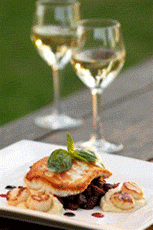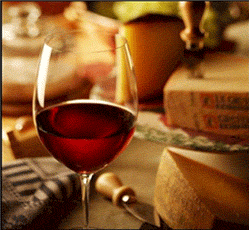 |
|
|
|
|
|
Matching Wine with Food
The right wine with the right food is a simple statement but difficult to define. In reality the right wine is the one that you enjoy drinking. There are well tried and tested conventions that will allow you to match food and wine so that you will be able to get more out of your dining experience. The generally accepted rule of "like with like" can assist:
|
– Sweet wine with sweet food
– Sour foods with acidic wines
– Bitter with bitter
– Salty food with acidic wines
– Red wine with red meat
– White wine with white meat |
 |
 |
There are of course many exceptions to this rule and dining has become far more exotic than in the past. It is also difficult to tell which wines are acidic or which retain bitterness.
Experience is the answer. Improvement of the palate and your perception of the four primary tastes of wine and food, sour, bitter, sweet and salt (in food only), will be able to help you understand what type of wine matches what type of food:
|
Wine type |
Food type |
Chardonnay
Medium to full-bodied, dry.
|
Poultry and game birds, veal and pork, rabbit fish and pasta preparations which feature cream and/or butter, mushrooms.
|
Sauvignon Blanc
Light-medium bodied, dry.
|
First courses, seafood, ethnic dishes—pastas, curries, salsas, spicy sausages, vegetable dishes, luncheon salads, olive-oil based dishes, tomato sauces, goat cheese.
|
Chenin Blanc
Light to medium-bodied, normally off-dry to semi-sweet.
|
Braised Chicken, sushi and other Oriental dishes, poultry, pork.
|
Traminer
Light to medium body, usually semi-sweet, occasionally off-dry.
|
Spicy cuisines such as Chinese, Mexican, and Indian, mild sausages, fruit salad.
|
Riesling
Light to medium bodied, semi-sweet to off-dry.
|
Crabmeat, appetizers and finger foods, pork, salads.
|
Semillon
Medium bodied dry white
|
Grilled fish, foods with creamy sauces such as pasta
|
Verdelho
Medium bodied dry white
|
Yabby, grilled fish, fruit platters and Italian pastas with cream based sauce
|
Cabernet Sauvignon
Medium to full-bodied, tannic and dry.
|
Beef, lamb, pork, duck, game meats, cheeses.
|
Merlot
Medium to full-bodied, less tannic than Cabernet, dry.
|
Beef, lamb, pork, duck, game meats, cheeses, stews, pizza, heart pastas.
|
Shiraz
Medium to full bodied
|
Beef fillet with tomato based sauce. Rich spicy meals. Veal, kangaroo, roast duck. Sparkling shiraz goes well with pastries and puddings.
|
Grenache
Medium to full bodied dry red
|
Fillet steak with tomato based sauce, sweet seafood, chicken and red meats
|
Pinot Noir
Medium to light-bodied, dry, little tannin leaves silky texture.
|
Lamb, duck, turkey, game birds, beef, rabbit, semi-soft cheeses.
|
Rosé
Vary greatly in the level of residual sugar (sweetness).
|
Best with smoked foods, quiche, pork and ham, Mexican and Thai food. Can be served with all food.
|
Brut
Dry
|
Aperitifs and first courses, fruits and nuts. Fuller bodied variations go well with any fish and chicken
|
Blanc de Noir
Dry but more fruity than Brut. Made from Red grapes only.
|
Aperitif, with lunch, desserts
|
Blanc de Blancs
Delicate dry wine made from white grapes only.
|
Caviar. Anytime
|
|
|
|
|
|
